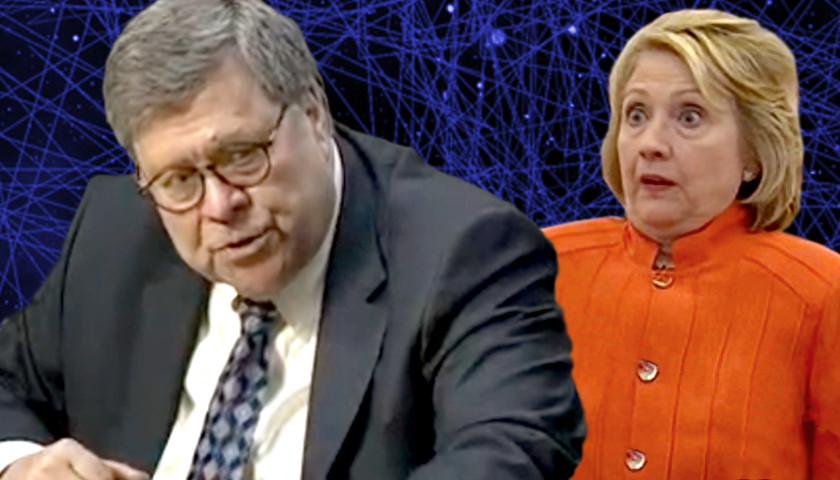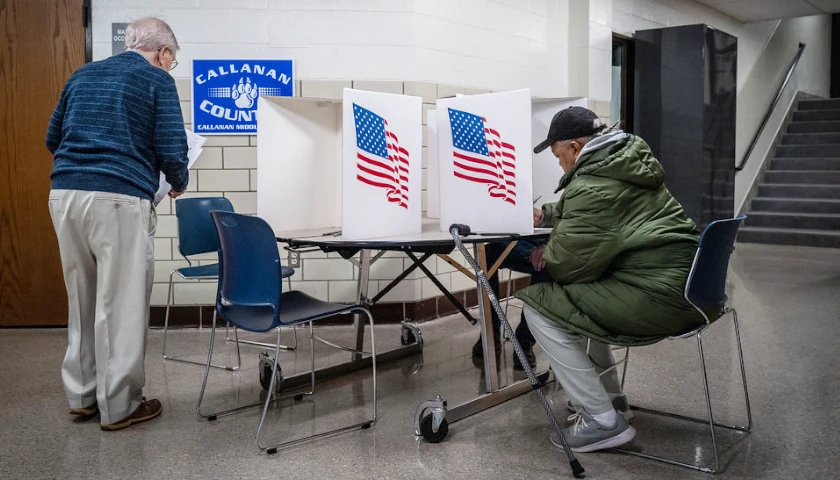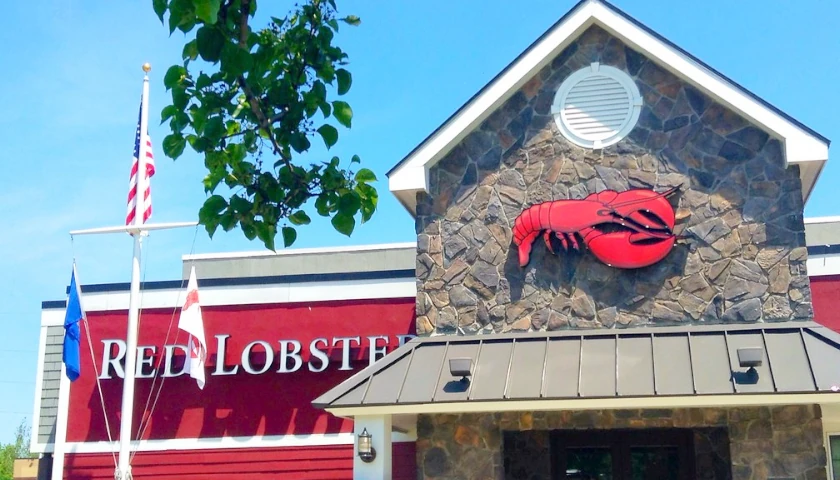by Robert Romano
The Hill’s John Solomon made big news on June 6 when he reported that Ukrainian businessman Konstantin Kilimnik, said in Special Counsel Robert Mueller’s report to be a Russian agent, was an intelligence source for the U.S. State Department.
“In a key finding of the Mueller report, Ukrainian businessman Konstantin Kilimnik, who worked for Trump campaign chairman Paul Manafort, is tied to Russian intelligence… What it doesn’t state is that Kilimnik was a ‘sensitive’ intelligence source for State going back to at least 2013 while he was still working for Manafort, according to FBI and State Department memos I reviewed.”
This is as startling revelation as any that has been discovered, since it calls into question whether somebody purported to be a Russian intelligence officer by the Justice Department really was. It also calls into question other contacts Trump campaign officials were said to have had with supposed Russian agents, and other actions said to have been perpetrated by supposed Russian agents.
Kilimnik was practically the entre basis for saying that Paul Manafort had at least been in touch with somebody connected with Russian intelligence. The Mueller report stated, “[O]n August 2, 2016, Trump campaign chairman Paul Manafort met in New York City with his long-time business associate Konstantin Kilimnik, who the FBI assesses to have ties to Russian intelligence. Kilimnik requested the meeting to deliver in person a peace plan for Ukraine that Manafort acknowledged to the Special Counsel’s Office was a ‘backdoor’ way for Russia to control part of eastern Ukraine; both men believed the plan would. require candidate Trump’s assent to succeed (were he to be elected President). They also discussed the status of the Trump Campaign and Manafort’s strategy for winning Democratic votes in Midwestern states. Months before that meeting, Manafort had caused internal polling data to be shared with Kilimnik, and the sharing continued for some period of time after their August meeting.”
But, if Kilimnik was not necessarily a Russian agent, but a sensitive intelligence asset of the U.S. State Department, it calls into question the entire basis for targeting Manafort in the Trump-Russia conspiracy probe by Mueller. It also calls into question the basis of Mueller’s indictment of Kilimnik. This exculpatory information seems to have been withheld from Manafort, and certainly has been withheld from the public eye.
This is not the first time in the investigation of Russian election interference that the Russian ties of figures in the investigation have been called into question.
Former Trump campaign foreign policy advisor George Papadopoulos who was convicted of lying to investigators after he was promised Hillary Clinton private server emails by Joseph Mifsud in 2016, supposedly by Russia. But Papadopoulos now alleges in his new book, “Deep State Target,” that the meetings he participated in were set up, not by Russian intelligence, but Western intelligence agencies to create the appearance that he was coordinating with Russia. In a Wall Street Journal oped published on April 18, Papadopoulos names Stefan Halper as an FBI informant, as well as Australian diplomat Alexander Downer and Mifsud, as all being individuals who spied on him to hurt the Trump campaign as a part of this plot.
The Mueller report identifies Papadopoulos as being the origin of the Russia collusion investigation by the FBI. Per Mueller: “On May 6, 2016, 10 days after that meeting with Mifsud, Papadopoulos suggested to a representative of a foreign government that the Trump Campaign had received indications from the Russian government that it could assist the Campaign through the anonymous release of information that would be damaging to Hillary Clinton… The foreign government conveyed this information to the U.S. government on July 26, 2016, a few days after WikiLeaks’s release of Clinton-related emails. The FBI opened its investigation of potential coordination between Russia and the Trump Campaign a few days later based on the information.”
But Papadopoulos says he was encouraged to meet Mifsud in the first place. On Twitter on March 30, he wrote, “a woman in London, who was the FBI’s legal attaché in the U.K. … encouraged me to meet Joseph Mifsud in Rome in March 2016…” So, if Papadopoulos was the genesis of this investigation because he spoke about his meeting with Mifsud to Downer, but the Mifsud meeting was a sting operation against him, then the investigation had to start before he spoke to Downer.
The key point would be that Papadopoulos might have never been in contact with Russian agents at all, something, by the way, that Mueller never directly stated, neither in his indictment of Papadopoulos nor in the Mueller report. Mifsud instead is simply stated to be someone who had “connections” with Russia. In Mueller’s own filings, he never actually says that Papadopoulos’ contacts were actual Russian intelligence operatives. There were tons of qualifiers used.
Mifsud, per the special counsel, “claimed to have substantial connections with Russian government officials.” Papadopoulos was said to have met Vladimir Putin’s “niece,” but Mueller’s statement of the offense only Papadopoulos “believed that she had connections to Russian government officials…” (sidenote: Putin has no niece.) Or, Papadopoulos was introduced to “an individual in Moscow … who told defendant Papadopoulos he had connections to the Russian Ministry of Foreign Affairs.” Nowhere does the statement of offense by Mueller confirm these contacts actually had the Russian connections they were purporting.
In the dossier by former British spy Christopher Steele, paid for by the Democratic National Committee and the Hillary Clinton campaign, which became the basis for a Foreign Intelligence Surveillance Act (FISA) warrant application taken out against the Trump campaign, alleged that not only had Russia hacked the Democrats and put the emails on Wikileaks, which was already public knowledge since June 2016, but that Trump and his campaign helped with “full knowledge and support” of the operation.
Former Trump campaign manager Paul Manafort, as well as campaign advisor Carter Page when he traveled to Moscow in July 2016, were both named by Steele as the key intermediaries to the Kremlin. Steele said then-Trump personal attorney Michael Cohen had traveled to Prague in the summer of 2016 to meet with Russian agents to mop up the fallout of the supposed operation.
Page was said to have met with Rosneft executive Igor Sechin. This was from the dossier, the specific (absurd) allegation was that Page had been offered a 19 percent stake in Rosneft, Russia’s state oil company, that would have been worth billions of dollars. There is no mention of a meeting with Sechin in the Mueller report by Page.
Maybe because it was not true. Moreover, the Mueller report found Page, Papdopoulos and Manafort were not Russian agents at all. The report stated, “In particular, the Office did not find evidence likely to prove beyond a reasonable doubt that Campaign officials such as Paul Manafort, George Papadopoulos, and Carter Page acted as agents of the Russian government — or at its direction, control or request — during the relevant time period.”
Manafort was brought up on unrelated tax and bank fraud charges. Cohen has his own set of problems, but being a Russian agent is not one of them. Per the Mueller report, “Cohen had never traveled to Prague…” And so, he very well could not have been there meeting with Russian intelligence officials.
Then there’s the question of Steele’s sources — which Barr needs to figure out and potentially declassify, no matter who it embarrasses. The Mueller report makes no effort to corroborate the Steele dossier or to vindicate its sources. Steele said they were Russian, but they are not named: Source A was a “former top Russian intelligence officer”; Source B was a “senior Russian Foreign Ministry figure”; Source C was a “senior Russian financial official”; Source D was a “close associate of Trump” (golden showers source); Source E was an “ethnic Russian close associate” of Trump (golden showers source); Source F was a “female staffer of the hotel”; and source G was a “senior Kremlin official”.
If Steele was telling the truth, that these Russian government sources had passed this information along to him, who was working for the DNC and Clinton campaign, which Mueller then discovered was not true, then it should have been considered by Mueller that it was potential Russian disinformation and another effort to interfere in the election. Yet, there is not a single mention of this potential in the Mueller report, despite the fact that Steele himself had concluded it was possible in court testimony, stating “all material contained this risk” of being disinformation. Steele didn’t go to Russia himself, and was said to have relied on a network to relay information, stating that the allegations needed to be “further corroborated and verified.” Were the sources of information even really Kremlin officials?
Further, were there any real Russian agents that met with the Trump campaign?
The American people have been subjected to a three year ordeal, a national nightmare (and embarrassment), and now we have numerous examples wherein Trump campaign officials said to have met with Russian agents have turned out to be complete fabrications or potentially highly misleading distortions. In short, lies.
It makes one question everything we’ve been told about this hoax.
Which is why Attorney General William Barr needs to take a second look at any time in the Mueller report or more broadly the Russia investigation actions were said by the Justice Department or intelligence agencies to have been directed by the Russian government and Vladimir Putin. That includes the DNC and John Podesta email hacks.
In the very least, Barr needs to address the hack because of the outstanding indictment on July 13, 2018 of several Russians said to be GRU intelligence operatives who Mueller alleges hacked the Democratic National Committee (DNC), the Democratic Congressional Campaign Committee (DCCC) and Clinton campaign chairman John Podesta and gave the emails to Wikileaks to be published.
The FBI apparently never took possession of the server, based upon publicly available information. In testimony on Jan. 10, 2017 before the Senate Intelligence Committee,then-FBI Director James Comey stated that “Ultimately what was agreed to is the private company [Crowdstrike] would share with us what they saw… Our forensics folks would always prefer to get access to the original device or server that’s involved, so it’s the best evidence.”
Here, Comey was referring to a private company analysis that was done of the DNC servers by Crowdstrike, which the FBI deferred to for evidence of the hack.
The FBI was given a copy of the server. According to Crowdstrike in a statement to the Washington Times on July 5, 2017, “In May 2016 CrowdStrike was brought to investigate the DNC network for signs of compromise, and under their direction we fully cooperated with every U.S. government request… [The cooperation included] providing of the forensic images of the DNC systems to the FBI, along with our investigation report and findings. Those agencies reviewed and subsequently independently validated our analysis.” Meaning, the FBI never had a verifiable chain of custody of the evidence in question.
As a general matter, a third party copy of the servers might not hold up in court, wrote Govtechworks.com’s Adam Stone in 2015: “Without the right protections, digital files can be easily deleted, edited, even fabricated. So documenting a digital chain of custody is all the more important. A compromised chain can undo a legal proceeding and lay waste to years of investigation. And all a defense attorney has to do is successfully raise concerns about potential tainting of evidence — that alone is enough, let alone demonstrating actual taint.”
Assuming there’s anything left to present to a court. When the DNC sued the Trump campaign, Russia and Wikileaks in 2018, its filing said the affected computer systems were decommissioned or copied over: “As a result of the persistence of the Russian state-sponsored infiltration, in order to remove the unauthorized users from its network, the DNC was required to decommission more than 140 servers, remove and reinstall all software, including the operating systems, for more than 180 computers, and rebuild at least 11 servers.”
So, there might be problems with prosecuting that case, and clearly, there never would have been an investigation into President Trump for helping Russia hack the DNC and Podesta, if not first for the investigation into the Russian hack. Barr needs to figure out what happened, if for no other reason, so the Justice Department can move forward with its prosecution of the Russian intelligence officers, or not, as the case may be.
The Jan. 6, 2017 Director of National Intelligence (DNI) assessment on Russian interference in the 2016 U.S. elections that Russia’s intent was to help President Donald Trump win the election.
It said: “We assess the influence campaign aspired to help President-elect Trump’s chances of victory when possible by discrediting Secretary Clinton and publicly contrasting her unfavorably to the President-elect.”
And: “We assess Putin, his advisers, and the Russian Government developed a clear preference for President-elect Trump over Secretary Clinton.”
Given all the disinformation that has been included in this investigation, supposedly sourced to Russia, can we even safely embrace that assessment anymore? If Kremlin officials were implicating Trump and his campaign in a conspiracy with Russia, that we now know did not happen, then perhaps they really were not trying to help Trump win the election, but to hurt him.
Finally, Wikileaks founder Julian Assange is now in British custody. He may have information that can at least shed light on what he knew about the DNC and Podesta emails. Does he still think the source was somebody besides Russia?
Now, just because sources linking the Trump campaign to Russian agents may not have been real does not at all refute the core allegation that Russia was behind the hacking. But the DNC and Clinton campaign were responsible for paying for the assessments that said Trump was a Russian agent and that Russia had been behind the hack. Were these initial assessments coordinated?
I’m not saying they were. But Barr needs to take a second look, not just at the investigation of Trump, but the entirety of the Russia investigation, including the DNC’s claims and the Jan. 2017 intelligence assessment to determine what the basis for the underlying intelligence against not just the Trump campaign but Russia too really was, and as Barr has promised to figure out, if it was adequately predicated.
– – –
Robert Romano is the Vice President of Pubic Policy at Americans for Limited Government.




